Special Design of Heavy Mass Base Foundations Methods in Rocks and Clay Soil Sub-Surfaces Techniques - Juniper publishers
Journal of Trends in Technical and Scientific Research
Abstract
These paper constitute consists of parts of
foundations design of under and sub structural plans. First of all,
foundations are the lowest artificially prepared parts of the structures
which are in direct contact with ground surfaces are known as
Foundations. But its different categories for the zones of ground
ability. Most of the foundations are normal status and load distribution
neutralizations in normal bearing values of depends upon the soils. But
rocks and clay soil zones areas not suited for normal sub structural
design methods. Its followed by high precious design sections and
execute the better results. And followed design methods is used for high
precious focus in mountain and steep constructions, Water-bearing area,
it's also better suitable in heavy constructions mass base foundation
methods of high rise buildings system.
Keywords: Rock boring; Grout hole; Anchorage bolting systems; Mass base trapezoidal foundations designs
Introduction
The soil ground on which the foundation's rest is
that foundation bed or foundation soil and it ultimate bearing of loads
and interact with the foundations of structure [1].
Case study and objective of foundations to distribute the total load
coming on the structure on a large area as well as great supported on
the structure and required enough stability of the structures against
various disturbing forces such eradicated climatic barriers. And to
prepare the level of surfaces for concreting and masonry work.
Inspections of sites its desirable to recognize the site of works and
inspect them carefully from the viewpoints of foundation details [2].
And to analyse the nature and thickness of strata of soil may be
estimated by studying the excavation detail of nearby constructionor by
examining the open side of a nearby well etc. the general inspection of
site of works serves of a good guide for determining the type of
foundation to be adopted for the proposed work and in addition, it helps
in getting the data with respects to used for design purposes. That
following data is used for items. The behaviour of ground due to
variation in depth of water table, Capacity of percolation of storm
water at the site, nature of the soil and visual analyzation, movement
of ground due to any reason [3].
Examinations of grounds, The load of the structure is ultimately
transferred to the soil it becomes, therefore, essential to know the
quality and thickness of soil undergrounds and such as a study would
assist in selecting an economical but safe design for the foundation of
the structure [4].
Methods
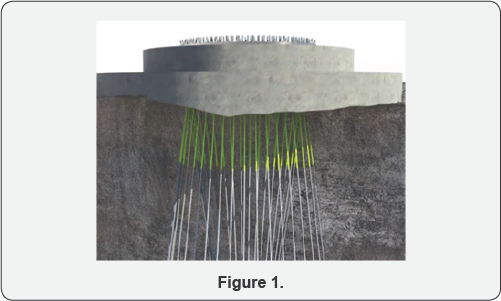
That Figure 1& 2
represents the special form of trapezoidal foundation mass basements
and deep grout anchorage systems. Its, essentially high interlock grip
effect with substructures to superstructures. Its typically handled in
50mm deep boreholes and required depth essentially carrying out of deep
boring for big important engineering structure [5].
Its methods anchor bolts rock concrete grout such as the addition to
the of the ability of superstructure, importance is to be given to
various other factors such as the same application in dams. Boring is
followed by the 2-methods, Percussions boring machines and core rotary
equipment.
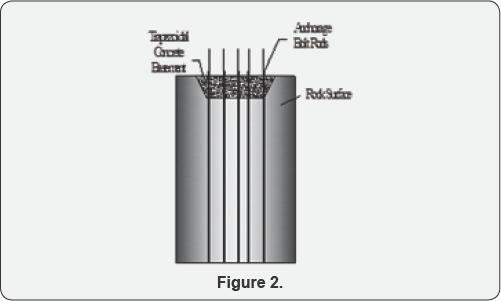
In this process, the heavy cutting tool is dropped
into the ground by means of a series of blows. That method used to
prefer in a semi layer hard rock soil and rock layer zones areas. The
broken rock material is brought to the ground by adding water into the
core and then the paste is lifted to the ground. The material thus
obtained is made dry and it is then examined. The percolations of boring
machines is very much use of hard rock zones areas [6],
And another condition it is very old method better results values and
created a large number of vibrations in heavy blowing. Some problems
cracking in nearest structures.
Core and rotary drilling machines
In this process, a hollow tube is driven by rotary
motion which cuts a solid core. Water is used to facilitate the cutting
process [7],
That machines can be used either for soft or hard rocks materials. If
the tube passes through a hard material, the core is retained and this
has to be cut at the bottom and lifted up [8],
This is done by pouring sand at the inner side between the core and
inner surface of the tube and then the tube is slightly rotated [9], The core is then broken and caught in the tube along with sand and it is lifted up.
Anchorage bolts and concrete systems assembly
After the 25 to 50mm boreholes and provided the bolting anchorage rods used in the rock in required foundations depths [10],
And its mostly used in peikko anchorage systems in better in rock
foundation methods. At one head of fixed bolt head into the provided in
required depth of rock. And after pouring the settling concrete. And
setting properly and to tighten the top of the bolting rod. Its better
frictions joints of the basement and foundations to substructures levels
[10]. Referred the design approach of followed in ASTM, A36, A307 (Grade B), A325, A449 and A687 [11].
Used in concrete. The Bolt threads at the surrounded closing stages of
apiece threaded steel bar are stake at top and bottom places below the
grave curse nut. That concrete is placed in well-hardened status in 14-
days after to tightening to bolt rotation.
Rock grouting
Boreholes in sufficient number are driven in the
ground. The concrete grout is then forced under pressure through these
bore holes [12].
These any of crack fissures of the rock are thus filled up, resulting
in the increased of bearing power of rock. Its process aided to some
other chemical treatment certain chemicals are used in place of cement
grout to solidify the but this process is adopted by small-scale
construction is costly it is only in case of important building.
Figure 3 & 4
Represents the Mass Trapezoidal basement foundations on clay and clayey
soils. Clay and clayey soil is a partial work in cohesive and cohesive
less in seasonal climatic conditions [13].
It is highly preferred in irrigations systems and not preferred in
shallow foundations. That foundation is broadly shallow spread over the
construction site area. Its possibly to constructed foundations are
termed trapezoidal basement foundation. In such spread case of overall
in a raft. And to assemble the assembly structural column sections. Its
high economical evaluation in compared to other pile foundations better
load transparent in cohesive soils.
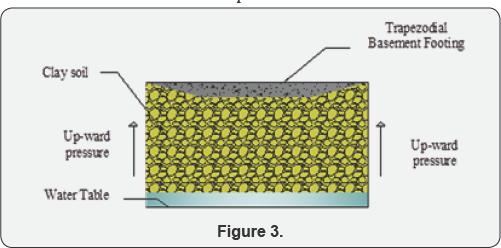
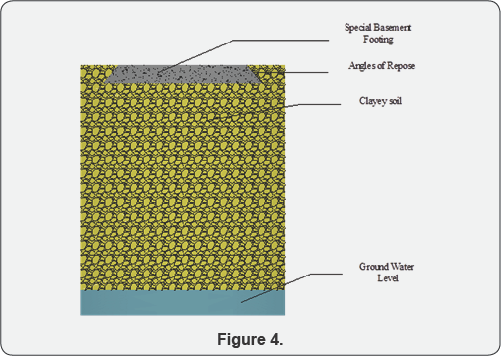
Design criteria of special mass basement footing
The total load to be transmitted by the walls or
columns to the foundation beds. The results of foundation pits and the
corresponding bearing capacity of each stratum of soil [14]. It respects to 2 aspects.
Width of foundations
A width of the special footing basement is decided by adopting the following rules:
If no footing is to be provided to the constructional
site area, it will provide the assumption columns should be provided in
required depth and equal areas as shown in Figure 1.
The total load including dead load and wind load coming on the columns
per meter length at are in case of heavy construction the load aspects
in the centre of the basement, it worked out. Then the width of the
foundation is obtained from the following relation.
a. For column,
The width of foundation basement = {Total load per meter length /allowable bearing capacity of the soil}
b. For piers,
The width of foundations basement = {Total load on the pier/allowable bearing capacity of the soil}
Usually, the wall, columns, piers are given with of
basements connects to plinth level. By adding the width of offset of
concrete, the total width of foundation can be obtained. And this width
of increased bearing pressure is vice versa to increase Table 1.
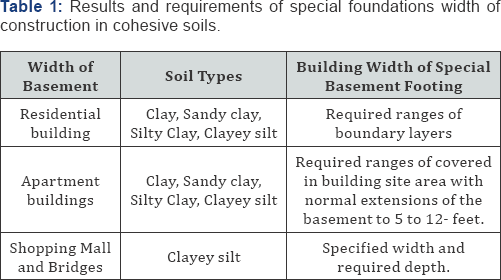
Depth of foundations
As a general rule, all the heavy mass base foundation
should be taken to a minimum depth of 80 cm below natural ground level
unless the hard soil is available within 80 cm. the total load is
transferred to the soil per square meter can be worked out and after the
study of the results of the trial pits, the foundation should be taken
to such a depth at which the soil has an allowable bearing capacity
greater than the value. The depth of foundations can also be obtained by
drawing the lines of angles 450 and 600 as shown in Table 2. Rafting
methods are increased the bearing power of soil becomes very useful when
the load coming on the soil is practically uniform while soil yielding
nature.
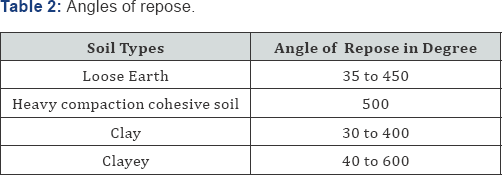
Conclusion
It is a final conclusion of the paper is special mass
base heavy foundation technique is followed by critical soil and Rock
category suitable preferred of the important structure. Such structure
has to be designed for heavy loads and ordinary methods of providing
foundations may not be suitable for structure. In that such case,
methods handling in special heavy basement footings is resisted to heavy
loads and increased the bearing capacity pressure of soil. That concept
of a method of increasing the bearing power of clayey soil becomes
useful, especially when there is used in a ground floor structure.
To Know More About Trends in Technical and ScientificResearch click on: https://juniperpublishers.com/ttsr/index.php
To Know More About Open Access Journals Please click on:



Comments
Post a Comment